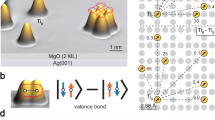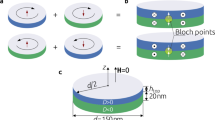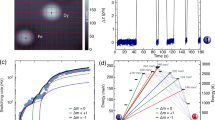Abstract
Single magnetic atoms, and assemblies of such atoms, on non-magnetic surfaces have recently attracted attention owing to their potential use in high-density magnetic data storage and as a platform for quantum computing1,2,3,4,5,6,7,8. A fundamental problem resulting from their quantum mechanical nature is that the localized magnetic moments of these atoms are easily destabilized by interactions with electrons, nuclear spins and lattice vibrations of the substrate3,4,5. Even when large magnetic fields are applied to stabilize the magnetic moment, the observed lifetimes remain rather short5,6 (less than a microsecond). Several routes for stabilizing the magnetic moment against fluctuations have been suggested, such as using thin insulating layers between the magnetic atom and the substrate to suppress the interactions with the substrate’s conduction electrons2,3,5, or coupling several magnetic moments together to reduce their quantum mechanical fluctuations7,8. Here we show that the magnetic moments of single holmium atoms on a highly conductive metallic substrate can reach lifetimes of the order of minutes. The necessary decoupling from the thermal bath of electrons, nuclear spins and lattice vibrations is achieved by a remarkable combination of several symmetries intrinsic to the system: time reversal symmetry, the internal symmetries of the total angular momentum and the point symmetry of the local environment of the magnetic atom.
This is a preview of subscription content, access via your institution
Access options
Subscribe to this journal
Receive 51 print issues and online access
$199.00 per year
only $3.90 per issue
Buy this article
- Purchase on Springer Link
- Instant access to full article PDF
Prices may be subject to local taxes which are calculated during checkout



Similar content being viewed by others
References
Gambardella, P. et al. Giant magnetic anisotropy of single cobalt atoms and nanoparticles. Science 300, 1130–1133 (2003)
Heinrich, A. J., Gupta, J. A., Lutz, C. P. & Eigler, D. M. Single-atom spin-flip spectroscopy. Science 306, 466–469 (2004)
Hirjibehedin, C. F. et al. Large magnetic anisotropy of a single atomic spin embedded in a surface molecular network. Science 317, 1199–1203 (2007)
Balashov, T. et al. Magnetic anisotropy and magnetization dynamics of individual atoms and clusters of Fe and Co on Pt(111). Phys. Rev. Lett. 102, 257203 (2009)
Loth, S., Etzkorn, M., Lutz, C. P., Eigler, D. M. & Heinrich, A. J. Measurement of fast electron spin relaxation times with atomic resolution. Science 329, 1628–1630 (2010)
Khajetoorians, A. A. et al. Itinerant nature of atom-magnetization excitation by tunneling electrons. Phys. Rev. Lett. 106, 037205 (2011)
Loth, S., Baumann, S., Lutz, C. P., Eigler, D. M. & Heinrich, A. J. Bistability in atomic-scale antiferromagnets. Science 335, 196–199 (2012)
Khajetoorians, A. A. et al. Current-driven spin dynamics of artificially constructed quantum magnets. Science 339, 55–59 (2013)
Fransson, J. Spin inelastic electron tunneling spectroscopy on local spin adsorbed on surface. Nano Lett. 9, 2414–2417 (2009)
Schuh, T. et al. Magnetic anisotropy and magnetic excitations in supported atoms. Phys. Rev. B 84, 104401 (2011)
Bleaney, B. & Stevens, K. W. H. Paramagnetic resonance. Rep. Prog. Phys. 16, 108–159 (1953)
Schuh, T. et al. Magnetic excitations of rare earth atoms and clusters on metallic surfaces. Nano Lett. 12, 4805–4809 (2012)
Wybourne, B. G. Spectroscopic Properties of Rare Earths Ch. 4.4, 166 (Wiley, 1965)
Coey, J. M. D. Magnetism and Magnetic Materials 114 (Cambridge Univ. Press, 2009)
Richter, M., Oppeneer, P., Eschrig, H. & &Johansson, B. Calculated crystal-field parameters of SmCo5 . Phys. Rev. B 46, 13919–13927 (1992)
Wiesendanger, R. Spin mapping at the nanoscale and atomic scale. Rev. Mod. Phys. 81, 1495–1550 (2009)
Rusponi, S. et al. The remarkable difference between surface and step atoms in the magnetic anisotropy of two-dimensional nanostructures. Nature Mater. 2, 546–551 (2003)
Zhou, L. et al. Strength and directionality of surface Ruderman-Kittel-Kasuya-Yosida interaction mapped on the atomic scale. Nature Phys. 6, 187–191 (2010)
Zhang, L., Miyamachi, T., Tomanić, T., Dehm, R. & Wulfhekel, W. A compact sub-Kelvin ultrahigh vacuum scanning tunneling microscope with high energy resolution and high stability. Rev. Sci. Instrum. 82, 103702 (2011)
Kresse, G. & Furthmüller, J. Efficient iterative schemes for ab initio total-energy calculations using a plane-wave basis set. Phys. Rev. B 54, 11169–11186 (1996)
Hafner, J. Ab-initio simulations of materials using VASP: density-functional theory and beyond. J. Comput. Chem. 29, 2044–2078 (2008)
Lüders, M., Ernst, A., Temmerman, W. M., Szotek, Z. & Durham, P. J. Ab initio angle-resolved photoemission in multiple-scattering formulation. J. Phys. Condens. Matter 13, 8587–8606 (2001)
Zeller, R. & Dederichs, P. H. Electronic structure of impurities in Cu, calculated self-consistently by Korringa-Kohn-Rostoker Green's-function method. Phys. Rev. Lett. 42, 1713–1716 (1979)
Perdew, J. P. & Zunger, A. Self-interaction correction to density-functional approximations for many-electron systems. Phys. Rev. B 23, 5048–5079 (1981)
Anisimov, V. I., Zaanen, J. & Andersen, O. K. Band theory and Mott insulators: Hubbard U instead of Stoner I. Phys. Rev. B 44, 943–954 (1991)
Acknowledgements
We acknowledge funding by the German Science Foundation (DFG) grant number Wu 349/4-2, the DFG priority programme SPP 1538 Spin Caloric Transport and the DFG Collaborative Research Centre SFB 762 Functionality of Oxide Interfaces. The calculations were performed at the Rechenzentrum Garching of the Max Planck Society.
Author information
Authors and Affiliations
Contributions
W.W. conceived the experiments, and T. Miyamachi, T.S., T. Märkl, A.S. and C.B. carried them out. The data were analysed by T. Miyamachi, T.S., T. Märkl, C.B., T.B. and W.W. Group theory of the crystal field was performed by T.S., T.B., C.B. and W.W. Master equations were analysed by C.K., S.A., M.M. and G.S. Ab initio calculations were performed by M.H., M.G., S.O., W.H., I.M. and A.E. The manuscript was written by T.B. and W.W. Figures were prepared by T. Miyamachi. All authors discussed the results and commented on the manuscript.
Corresponding author
Ethics declarations
Competing interests
The authors declare no competing financial interests.
Supplementary information
Supplementary Information
This file contains Supplementary Text and Data, Supplementary Figures 1-3, Supplementary Tables 1-2 and Supplementary References. (PDF 1146 kb)
Rights and permissions
About this article
Cite this article
Miyamachi, T., Schuh, T., Märkl, T. et al. Stabilizing the magnetic moment of single holmium atoms by symmetry. Nature 503, 242–246 (2013). https://doi.org/10.1038/nature12759
Received:
Accepted:
Published:
Issue Date:
DOI: https://doi.org/10.1038/nature12759
This article is cited by
-
Engineering atomic-scale magnetic fields by dysprosium single atom magnets
Nature Communications (2021)
-
The Mott to Kondo transition in diluted Kondo superlattices
Communications Physics (2019)
-
Large magnetic anisotropy in chemically engineered iridium dimer
Communications Physics (2018)
-
Phonon-driven spin-Floquet magneto-valleytronics in MoS2
Nature Communications (2018)
-
The geometric phase of Zn- and T-symmetric nanomagnets as a classification toolkit
Scientific Reports (2017)
Comments
By submitting a comment you agree to abide by our Terms and Community Guidelines. If you find something abusive or that does not comply with our terms or guidelines please flag it as inappropriate.



